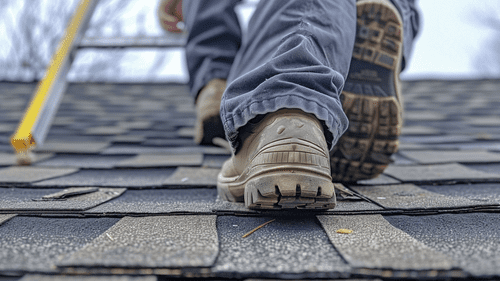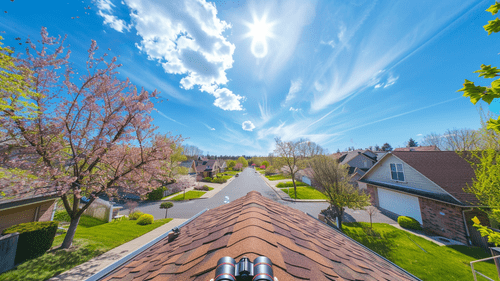Introduction
Have you ever wondered why some homes stay cooler in the summer and warmer in the winter without breaking the bank on energy costs? The secret often lies above your head, in the often-overlooked world of roof ventilation. Proper ventilation not only enhances home comfort but also plays a critical role in energy efficiency. But what exactly happens when your roof breathes well, and how does this affect your living space and utility bills?
In exploring the essentials of roof ventilation, we'll uncover how strategic airflow can prevent the buildup of damaging moisture and why a cool roof might be the energy-saving solution you've been looking for. Whether you're in a snow-prone area or a tropical locale, understanding the right ventilation strategy for your climate can make a significant difference. Ready to find out how simple adjustments in your attic can lead to substantial benefits throughout your home? Let’s get you covered with insights that ensure peace of mind and a more efficient living environment.
Understanding the Role of Heat and Moisture in Roof Ventilation
The Dynamics of Heat Flow in Attics
Heat accumulation within a home can lead to increased energy costs, making roof ventilation a critical component in managing this issue. By facilitating the escape of hot air that naturally rises, proper ventilation helps maintain a balance between indoor and outdoor air, preventing the attic from turning into a 'pressure cooker'. This not only reduces the load on air conditioning systems but also enhances overall energy efficiency.
Crucial Moisture Control for Roof Health
Moisture might not be the first concern when thinking about roof health, but it plays a significant role. Activities such as cooking and showering can lead to moisture buildup, which, without adequate ventilation, can foster the growth of mold and mildew. These can damage your home's structural integrity. Ensuring a continuous flow of air through effective roof ventilation keeps attic spaces dry and prevents costly repairs due to moisture damage.
Maximizing Home Efficiency with Cool Roofs
How Cool Roofs Contribute to Energy Savings
The installation of a cool roof can lead to substantial energy conservation, benefiting homeowners financially and environmentally. By reflecting sunlight and heat away from the building, these roofs significantly lower roof temperatures during hot weather, which translates to savings of up to 15% on cooling costs.
The Significant Temperature Difference of Reflective Roofs
The temperature disparity between a reflective and a non-reflective roof can be quite dramatic, with the former staying over 50°F cooler. This reduction in heat penetration into the home means that air conditioning systems can operate more efficiently and less frequently, further enhancing energy savings and reducing environmental impact.
Tailored Ventilation Strategies for Diverse Climates
Ventilation Techniques for Warm Climates
In warmer regions, the primary goal of roof ventilation is to expel hot air effectively to minimize heat accumulation. Implementing ridge vents or larger soffit vents can significantly improve this process. These techniques help maintain cooler indoor temperatures and reduce dependency on mechanical cooling, offering a natural and cost-effective cooling solution.
Adapting Ventilation for Cold Climates
In contrast, colder climates require strategies that focus on retaining warmth while preventing moisture issues. Using insulated vent ducts can prevent heat loss and stop moisture from condensing in the attic. This approach is essential for maintaining a warm, dry interior and preventing ice dams on the roof.
Choosing and Implementing the Right Ventilation System
Overview of Ventilation System Types
Selecting an appropriate ventilation system is essential for effective energy management. Available options include:
- Ridge Vents: These are ideal for achieving uniform ventilation across the roof.
- Turbines: Effective in regions with consistent wind.
- Static Vents: A simple and economical choice for moderate climates.
- Gable Vents: These are typically used in conjunction with other ventilation strategies.
Each system offers specific benefits and is suitable for different roof designs and climatic conditions, making a careful choice crucial for optimal functionality.
The Importance of Professional Installation
While DIY projects may seem appealing, the installation of roof ventilation systems generally requires professional expertise to ensure effectiveness. Improper installation can lead to inadequate ventilation, negating the benefits of the system. Professional installation ensures that the roof ventilation is optimized for maximum efficiency and effectiveness.
Ensuring Long-Term Roof Performance through Maintenance
Enhancing Durability and Extending Roof Lifespan
Proper ventilation plays a significant role in extending the lifespan of your roof. It prevents extreme temperature fluctuations and moisture buildup, which can cause thermal stress and moisture damage. These are common factors that lead to premature aging of roofing materials.
Importance of Regular Maintenance Checks
To keep your roof ventilation system in optimal condition, regular maintenance checks are crucial. These should include:
- Inspecting vents for blockages or debris.
- Checking mechanical vents for signs of rust or damage.
- Ensuring that vents are not obstructed by insulation or other materials.
Regular maintenance allows for the early detection of issues, facilitating timely interventions that maintain the system's efficiency.
Wrapping It Up: The Essentials of Roof Ventilation
Understanding the dynamics of heat and moisture in your attic through effective roof ventilation is crucial for maintaining a comfortable and energy-efficient home. By implementing strategies tailored to your specific climate—whether it's installing cool roofs in warmer areas or optimizing moisture control in colder regions—you're not just saving on energy costs but also enhancing the longevity of your roof. Proper ventilation systems, when professionally installed, ensure that your home remains a safe, dry, and cost-effective living space.
Reflecting on the importance of a well-ventilated roof, it's clear that this often-overlooked aspect of home maintenance can significantly impact both your living environment and your wallet. Remember, a well-maintained roof does more than prevent problems; it improves the overall quality of your life at home. As you consider the health of your roof, think of it as the protective barrier that keeps your sanctuary comfortable and secure, no matter what the weather brings.







